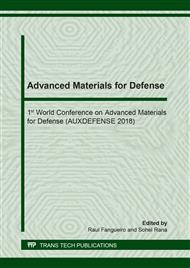[1]
N. Pan, G. Sun, Functional textiles for improved performance, protection and health, first ed., Woodhead Publishing Series in Textiles, Cambridge, (2011).
DOI: 10.1016/b978-1-84569-723-5.50025-3
Google Scholar
[2]
E. Sparks, Advances in Military Textiles and Personal Equipment, first ed., Woodhead Publishing Limited, Cambridge, (2012).
Google Scholar
[3]
S. G. Burnay, T. L. Williams, C.N. Jones, Applications of thermal imaging, first ed., Adam Hilger, Bristol, (1988).
Google Scholar
[4]
T. Wang, J. He, J. Zhou, X. Ding, J. Zhao, S. Wu, Y. Guo, Electromagnetic wave absorption and infrared camouflage of ordered mesoporous carbon - Alumina nanocomposites, Microporous and Mesoporous Materials. 134 (2010) 58-64.
DOI: 10.1016/j.micromeso.2010.05.007
Google Scholar
[5]
A.R. Horrocks, S. C. Anand, Handbook of Technical Textiles, first ed., Woodhead Publishing Limited, Cambridge, (2000).
Google Scholar
[6]
Y. Li, A.S.W Wong, Clothing biosensory engineering, first ed., Woodhead Publishing Limited, Cambridge, (2006).
Google Scholar
[7]
L. Pires, P. Silva, L. C. Gonçalves, Potencialidades da termografia por infravermelhos e sua aplicação a sistemas de condicionamento de ar e de refrigeração, Climatização, Revista bimestral de aquecimento, ar condicionado, ventilação e energia. 25 (2003) 38-44.
DOI: 10.26512/2016.04.d.21305
Google Scholar
[8]
X. Yin, Q. Chen, N. Pan, Feasibility of perspiration based infrared Camouflage, Applied Thermal Engineering. 36 (2011) 32-38.
DOI: 10.1016/j.applthermaleng.2011.12.001
Google Scholar
[9]
E. Wilusz, Military Textiles, first ed., Woodhead Publishing Limited, Cambridge, (2008).
Google Scholar
[10]
I. P. Herman, Physics of the human body, second ed., Springer, Switzerland, (2016).
Google Scholar
[11]
P. Elsner, K. Hatch, W. Wigger-Alberti, Textiles and the Skin, Karger, Switzerland, (2003).
Google Scholar
[12]
N. Pan, P. Gibson, Thermal and moisture transport in fibrous materials, first ed., Woodhead Publishing Limited, Cambridge, (2006).
Google Scholar
[13]
L. Fourt, N. R. S. Hollies, Clothing: Comfort and Function, Marcel Dekker Inc, New York, (1970).
Google Scholar
[14]
J. Xin, Total colour management in textiles, Woodhead Publishing Limited, Cambridge, (2006).
Google Scholar
[15]
H. Zhang, T. L. Hu, J. Ch. Zhang, Surface emissivity of fabric in the 8-14 μm waveband, The Journal of The Textile Institute. 100:1 (2009) 90-94.
DOI: 10.1080/00405000701692486
Google Scholar
[16]
D. Banerjee, S. K. Chattopadhyay, S. Tuli, Infrared thermography in material research – A review of textile applications, Indian Journal of Fibre & Textile Research, 38 (2012) 427-437.
Google Scholar
[17]
V. Rubenžiene, I. Padleckienė, S. Varnaitė-žuravliova, J. Baltušnikaitė, Reduction of Thermal Signature Using Fabrics with Conductive Additives, Materials Science. 19 (2013) 409-414. DOI: http://dx.doi.org/10.5755/j01.ms.19.4.1730.
DOI: 10.5755/j01.ms.19.4.1730
Google Scholar
[18]
X. He, L. Wu, Illusion thermodynamics: A camouflage technique changing an object into another one with arbitrary cross section, Appl. Phys. Lett. 105, 221904 (2014).
DOI: 10.1063/1.4903170
Google Scholar
[19]
C. Pimenta, A Camuflagem Térmica no Design de Moda Conceptual, Master's Thesis, University of Beira Interior, Portugal, (2013).
Google Scholar
[20]
Information on http://ahprojects.com/projects/stealth-wear/.
Google Scholar
[21]
Information on http://ravenaerostar.com/products/protective-wear/product-overview-1.
Google Scholar
[22]
Information on http://www.bluechersystems.com/produkte/C10.
Google Scholar
[23]
Information on http://www.bluecher.com/en/brands/.
Google Scholar
[24]
Information on http://www.baesystems.com/product/BAES_031457/adaptiv---state-of-the-arttechnology?_afrLoop=2086408668088000.
Google Scholar


